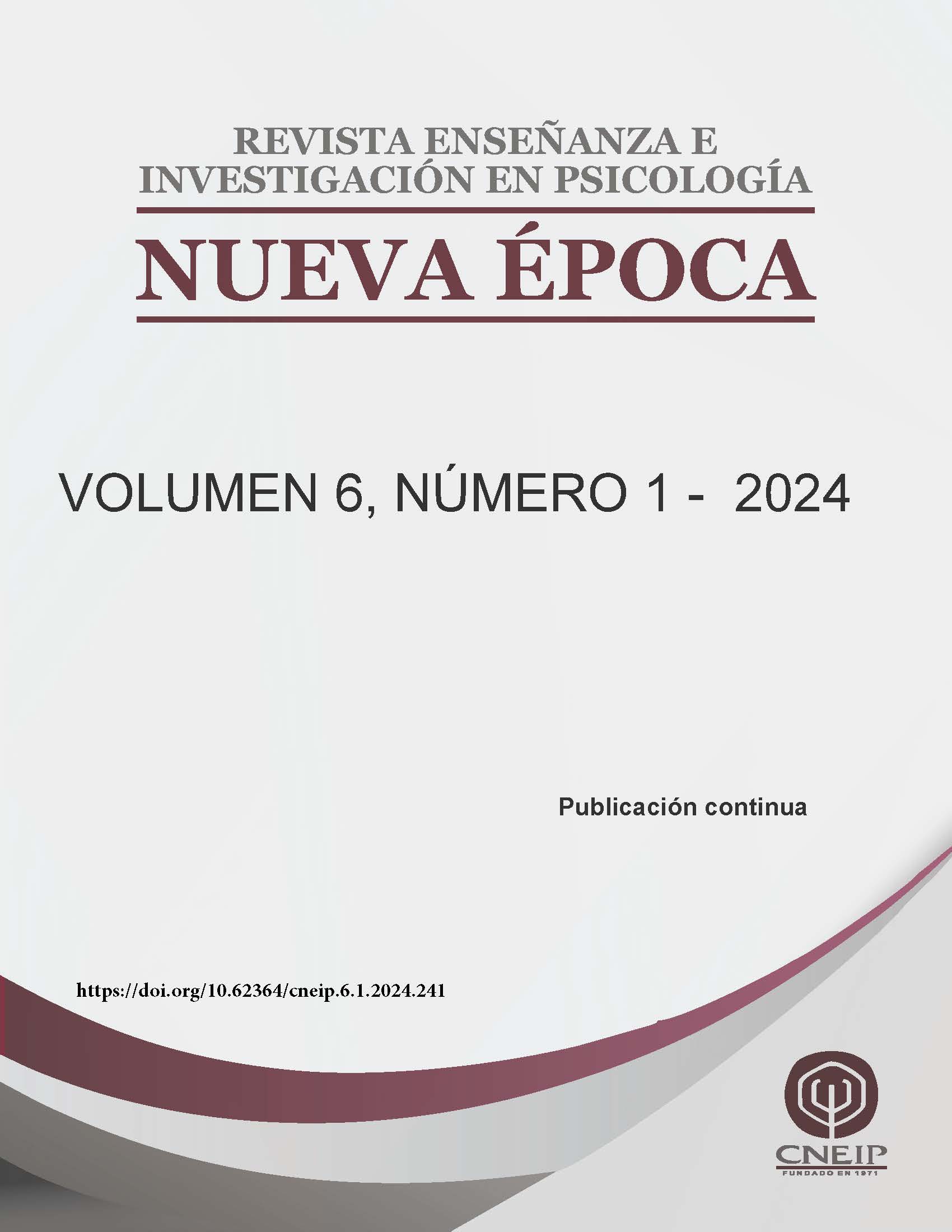Abstract
This study examines the mediating effect of burnout (OD) between psychosocial risk factors (PRF) and psychological well-being (BP). Through intentional sampling, 258 high school teachers from various public institutions in the city of Toluca and its metropolitan area participated, of which 124 were men and 134 were women with an average age of 41 years (SD = 8.46). Applying the Psychosocial Risk Evaluation Questionnaire, the Occupational Burnout Scale and the Psychological Well-being Questionnaire. The results of the simple mediation model allow us to conclude that there is a negative effect of the FRP towards the BP and this increases due to the indirect effect of the DO. The effects of the interactions of the analyzed variables are evident, which leads to the need to promote psychological well-being in the workplace by preventing the elements that cause it to decrease.
References
Arias, W. L., Huamani, J. C., & Ceballos, K. D. (2019). Burnout Syndrome in School Teachers and University Professors: A Psychometrical and Comparative Analysis from Arequipa City. Journal of Educational Psychology-Propositos y Representations, 7(3), 92-113. https://doi.org/10.20511/pyr2019.v7n3.390
Baron, R. M., & Kenny, D. A. (1986). The moderator-mediator variable distinction in social psychological research: Conceptual, strategic and statistical considerations. Journal of Personality and Social Psychology, 51, 1173-1182 https://doi.org/10.1037/0022-3514.51.6.1173
Brito, L. J. (2018). Calidad educativa en las instituciones de educación superior : evaluación del síndrome de burnout en los profesores. Revista Iberoamericana Para La Investigación y El desarrollo educativo, 8(16), 516–534. https://doi.org/10.23913/ride.v8i16.356
Cámara de Diputados del H. Congreso de la Unión. (2021) Ley General de Salud. http://www.diputados.gob.mx/LeyesBiblio/pdf_mov/Ley_General_de_Salud.pdf
Cherniss, C. (1980) Staff Burnout Job Stress in the Human Services, Beverly Hills Sage.
Cohen J. (1988) Statistical power analysis for the behavioral sciences. Hillsdale, N.J: L. Erlbaum Associates
Díaz, D., Rodríguez-Carvajal, R., Blanco, A., Moreno-Jiménez, B., Gallardo, I.,
Valle, C., & Van Dierendonck, D. (2006). Adaptación española de las escalas de bienestar psicológico de Ryff. Psicothema, 18(3), 572-577. https://www.redalyc.org/pdf/727/72718337.pdf
Fernández, M. P. (2017). Relación entre Desgaste ocupacional y manifestaciones psicosomáticas en una muestra de docentes colombianos de la ciudad de Santa Marta. Archivos de Medicina (Manizales), 17(1), 78-90. https://doi.org/10.30554/archmed.17.1.1910.2017
Forbes (21 de diciembre de 2017). Mexicanos los más estresados del mundo por su trabajo. https://www.forbes.com.mx/mexicanos- los- mas-estresados-del- mundo-por-su-trabajo/
Freudenberger, H. J. (1974). ‘Staff burn-out’, Journal of Social Issues, 30 (1), 159-165.
https://doi.org/10.1111/j.1540-4560.1974.tb00706.x
García del Castillo, J. A., García del Castillo, Á., López-Sánchez, C., & Díaz, P. C. (2016). Conceptualización teórica de la resiliencia psicosocial y su relación con la salud, Salud y drogas 16(1), 59-68. https://rua.ua.es/dspace/bitstream/10045/54245/1/2016_Garcia-del-Castillo_etal_H%26A.pdf
Gil-Monte, P.R. (2012). Riesgos psicosociales en el trabajo y salud ocupacional. Revista Peruana de Medicina Experimental y Salud Pública, 29(2) 237-241. https://www.scielosp.org/pdf/rpmesp/2012.v29n2/237-241/es
Hair, J. F., Anderson, R. E., Tatham, R. L., & Black, W. C. (2004). Análisis multivariante. Pearson Prentice Hall.
Hayes, A.F. (2013). Introduction to mediation, moderation and conditional process analysis. A regression based approach. The Guilford Press
Hernández, S., Fernández, C., & Baptista, L. (2014). Metodología de la investigación. McGraw-Hill.
Johnson, S., Robertson, I., & Cooper, C. L. (2018). WELL-BEING Productivity and Happiness at Work. Palgrave Macmillan.
López, P. L. (2004). Población muestra y muestreo. Punto cero, 9(08), 69-74. http://www.scielo.org.bo/pdf/rpc/v09n08/v09n08a12.pdf
Luceño, L., & Martín, J. (2008). DECORE: Cuestionario de Evaluación de Riesgos Psicosociales. TEA Ediciones: Madrid.
Luna, D., Figuerola-Escoto, R.P., Contreras-Ramírez, J., Sierra-Monge, J.J.L., Navarreta- Rodriguez, E.M., Serret, J., Castañeda, P. & Meneses-González, F., (2020) "Propiedades psicométricas de la Escala de Bienestar Psicológico para Adolescentes (BIEPS-J) en una muestra mexicana." Psicodebate. Psicología, Cultura y Sociedad 20(1) 43-55. http://dx.doi.org/10.18682/pd.v20i1.957
Magaña-Medina, D. E., & Sánchez-Escobedo, P. (2013). Burnout and Role Ambiguity in Mexican Universities : A case study. Revista Educación y Ciencia, 3(41). https://www.researchgate.net/publication/307205342_Burnout_and_Role_Ambiguity_ 84 in_ Mexican_Universities_A_case_study
Mateo, C. M., Hernández, M. P., & Cabrero, R. S. (2019). El bienestar psicológico en la adolescencia: Variables psicológicas asociadas y predictoras. European journal of education and psychology, 12(2), 139-151. https://doi.org/10.30552/ejep.v12i2.279
Organización Mundial de la Salud (2019). Burn-out "occupational phenomenon": International Classification of Diseases” https://www.who.int/news/item/28-05-2019-burn-out-an-occupational phenomenon- international-classification-of-diseases
Oviedo, H. C., & Campo-Arias, A. (2005). Aproximación al uso del coeficiente alfa de Cronbach. Revista colombiana de psiquiatría, 34(4), 572-580. http://www.scielo.org.co/scielo.php?pid=s0034-74502005000400009&script=sci_arttext
Ruiz de Chávez, D., Pando-Moreno, M., Aranda, B. C. B. C., & Almeida, P. C. (2014). Burnout y Work Engagement en Docentes Universitarios de Zacatecas. Ciencia y Trabajo, 16(50), 116–120. https://doi.org/10.4067/S0718-24492014000200010
Ryff, C. (1995). Psychological Well-Being in Adult Life. Current Directions in Psychological Science, 4(4), 99-104. http://www.jstor.org/stable/20182342
Sandoval, S., Dorner, A., & Véliz, A. (2017). Bienestar psicológico en estudiantes de carreras de la salud. Investigación en Educación Médica, 6(24), 260-266. https://doi.org/10.1016/j.riem.2017.01.004
Seligman, M. E. P. (2002). Authentic Happiness. Simon and Schuster.
Shadish, W.R., Cook, T.D., & Campbell, D.T. (2002) Experimental and Quasi-Experimental Designs for Generalized Causal Inference. Cengage Learning.
Sociedad Mexicana de Psicología. (2010). Código Ético del Psicólogo. Trillas.
Uribe-Prado, J. F. (2020). Riesgos psicosociales, burnout y factores psicosomáticos en servidores públicos. Investigación administrativa, 49(125).
https://doi.org/10.35426/iav49n125.03
Uribe-Prado, J. F. (2016). Psicología del trabajo: Un entorno de factores psicosociales saludables para la productividad. Editorial El Manual Moderno.
Valerio, G. & Serna R. (2018). Redes sociales y bienestar psicológico del estudiante universitario. Revista electrónica de investigación educativa, 20(3), 19- 28. https://doi.org/10.24320/redie.2018.20.3.1796
Van Dierendonck, D. (2004). The construct validity of Ryff´s scales of psychological well- being and its extension with spiritual well-being. Personality and Individual Differences, 36(3), 629-644. https://doi.org/10.1016/S0191-8869(03)00122-3
Valle, M. & Ponce, L.E(2017). Diseño de un programa estratégico para prevenir y reducir la incidencia de mobbing y burnout en un plantel de EMS de la Ciudad de Toluca. [Tesis de Maestría, Universidad Autónoma del Estado de México].
World Medical Association. (2013). World Medical Association Declaration of Helsinki: ethical principles for medical research involving human subjects. Jama, 310(20), 2191- 2194. doi:10.1001/jama.2013.2

This work is licensed under a Creative Commons Attribution-NonCommercial-NoDerivatives 4.0 International License.
Copyright (c) 2024 Enseñanza e Investigación en Psicología





